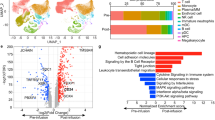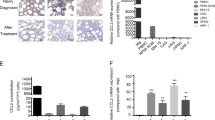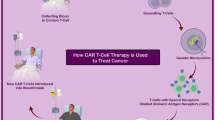Abstract
Our previous studies showed that macrophages (MФs), especially myeloma-associated MФs (MAMs), induce chemoresistance in human myeloma. Here we explored the potential of targeting MФs, by using colony-stimulating factor 1 receptor (CSF1R)-blocking mAbs, to treat myeloma. Our results showed that CSF1R blockade specifically inhibited the differentiation, proliferation and survival of murine M2 MФs and MAMs, and repolarized MAMs towards M1-like MФs in vitro. CSF1R blockade alone inhibited myeloma growth in vivo, by partially depleting MAMs, polarizing MAMs to the M1 phenotype, and inducing a tumor-specific cytotoxic CD4+ T-cell response. Similarly, genetically depleting MФs in myeloma-bearing MMDTR mice retarded myeloma growth in vivo. Furthermore, the combination of CSF1R blockade and chemotherapy such as bortezomib or melphalan displayed an additive therapeutic efficacy against established myeloma. Finally, a fully human CSF1R blocking mAb, similar to its murine counterpart, was able to inhibit the differentiation, proliferation and survival of human MФs. Thus, this study provides the first direct in vivo evidence that MΦs and MAMs are indeed important for myeloma development and progression. Our results also suggest that targeting MAMs by CSF1R blocking mAbs may be promising methods to (re)sensitize myeloma cells to chemotherapy and promote anti-myeloma immune responses in patients.
This is a preview of subscription content, access via your institution
Access options
Subscribe to this journal
Receive 12 print issues and online access
$259.00 per year
only $21.58 per issue
Buy this article
- Purchase on Springer Link
- Instant access to full article PDF
Prices may be subject to local taxes which are calculated during checkout








Similar content being viewed by others
References
Hideshima T, Mitsiades C, Tonon G, Richardson PG, Anderson KC . Understanding multiple myeloma pathogenesis in the bone marrow to identify new therapeutic targets. Nat Rev Cancer 2007; 7: 585–598.
Podar K, Chauhan D, Anderson KC . Bone marrow microenvironment and the identification of new targets for myeloma therapy. Leukemia 2009; 23: 10–24.
Gordon S, Taylor PR . Monocyte and macrophage heterogeneity. Nat Rev Immunol 2005; 5: 953–964.
Wynn TA, Chawla A, Pollard JW . Macrophage biology in development, homeostasis and disease. Nature 2013; 496: 445–455.
Biswas SK, Mantovani A . Macrophage plasticity and interaction with lymphocyte subsets: cancer as a paradigm. Nat Immunol 2010; 11: 889–896.
Gordon S, Martinez FO . Alternative activation of macrophages: mechanism and functions. Immunity 2010; 32: 593–604.
Kurahara H, Shinchi H, Mataki Y, Maemura K, Noma H, Kubo F et al. Significance of M2-polarized tumor-associated macrophage in pancreatic cancer. J Surg Res 2011; 167: e211–e219.
Colegio OR, Chu NQ, Szabo AL, Chu T, Rhebergen AM, Jairam V et al. Functional polarization of tumour-associated macrophages by tumour-derived lactic acid. Nature 2014; 513: 559–563.
Hao NB, Lu MH, Fan YH, Cao YL, Zhang ZR, Yang SM . Macrophages in tumor microenvironments and the progression of tumors. Clin Dev Immunol 2012; 2012: 948098.
Williams CB, Yeh ES, Soloff AC . Tumor-associated macrophages: unwitting accomplices in breast cancer malignancy. NPJ Breast Cancer 2016; 2: 15025.
Zheng Y, Cai Z, Wang S, Zhang X, Qian J, Hong S et al. Macrophages are an abundant component of myeloma microenvironment and protect myeloma cells from chemotherapy drug-induced apoptosis. Blood 2009; 114: 3625–3628.
Zheng Y, Yang J, Qian J, Qiu P, Hanabuchi S, Lu Y et al. PSGL-1/selectin and ICAM-1/CD18 interactions are involved in macrophage-induced drug resistance in myeloma. Leukemia 2013; 27: 702–710.
Priceman SJ, Sung JL, Shaposhnik Z, Burton JB, Torres-Collado AX, Moughon DL et al. Targeting distinct tumor-infiltrating myeloid cells by inhibiting CSF-1 receptor: combating tumor evasion of antiangiogenic therapy. Blood 2010; 115: 1461–1471.
Zhu Y, Knolhoff BL, Meyer MA, Nywening TM, West BL, Luo J et al. CSF1/CSF1R blockade reprograms tumor-infiltrating macrophages and improves response to T-cell checkpoint immunotherapy in pancreatic cancer models. Cancer res 2014; 74: 5057–5069.
Aharinejad S, Paulus P, Sioud M, Hofmann M, Zins K, Schafer R et al. Colony-stimulating factor-1 blockade by antisense oligonucleotides and small interfering RNAs suppresses growth of human mammary tumor xenografts in mice. Cancer Res 2004; 64: 5378–5384.
Mantovani A, Allavena P . The interaction of anticancer therapies with tumor-associated macrophages. J Exp Med 2015; 212: 435–445.
Pollard JW . Trophic macrophages in development and disease. Nat Rev Immunol 2009; 9: 259–270.
Pyonteck SM, Akkari L, Schuhmacher AJ, Bowman RL, Sevenich L, Quail DF et al. CSF-1R inhibition alters macrophage polarization and blocks glioma progression. Nat Med 2013; 19: 1264–1272.
Ries CH, Cannarile MA, Hoves S, Benz J, Wartha K, Runza V et al. Targeting tumor-associated macrophages with anti-CSF-1R antibody reveals a strategy for cancer therapy. Cancer Cell 2014; 25: 846–859.
Yamashiro S, Takeya M, Nishi T, Kuratsu J, Yoshimura T, Ushio Y et al. Tumor-derived monocyte chemoattractant protein-1 induces intratumoral infiltration of monocyte-derived macrophage subpopulation in transplanted rat tumors. Am j Pathol 1994; 145: 856–867.
Davis MJ, Tsang TM, Qiu Y, Dayrit JK, Freij JB, Huffnagle GB et al. Macrophage M1/M2 polarization dynamically adapts to changes in cytokine microenvironments in Cryptococcus neoformans infection. MBio 2013; 4: e00264–00213.
Zhang X, Edwards JP, Mosser DM . Dynamic and transient remodeling of the macrophage IL-10 promoter during transcription. J Immunol 2006; 177: 1282–1288.
Yue Y, Huang W, Liang J, Guo J, Ji J, Yao Y et al. IL4I1 Is a novel regulator of M2 macrophage polarization that can inhibit T cell activation via L-tryptophan and arginine depletion and IL-10 production. PLoS One 2015; 10: e0142979.
Van Overmeire E, Stijlemans B, Heymann F, Keirsse J, Morias Y, Elkrim Y et al. M-CSF and GM-CSF receptor signaling differentially regulate monocyte maturation and macrophage polarization in the tumor microenvironment. Cancer Res 2016; 76: 35–42.
Edwards JP, Zhang X, Frauwirth KA, Mosser DM . Biochemical and functional characterization of three activated macrophage populations. J Leukoc Biol 2006; 80: 1298–1307.
Murray PJ, Allen JE, Biswas SK, Fisher EA, Gilroy DW, Goerdt S et al. Macrophage activation and polarization: nomenclature and experimental guidelines. Immunity 2014; 41: 14–20.
Martinez FO, Gordon S . The M1 and M2 paradigm of macrophage activation: time for reassessment. F1000Prime Rep 2014; 6: 13.
Martinez FO, Helming L, Milde R, Varin A, Melgert BN, Draijer C et al. Genetic programs expressed in resting and IL-4 alternatively activated mouse and human macrophages: similarities and differences. Blood 2013; 121: e57–e69.
Cassol E, Cassetta L, Rizzi C, Alfano M, Poli G . M1 and M2a polarization of human monocyte-derived macrophages inhibits HIV-1 replication by distinct mechanisms. J Immunol 2009; 182: 6237–6246.
Jablonski KA, Amici SA, Webb LM, Ruiz-Rosado Jde D, Popovich PG, Partida-Sanchez S et al. Novel markers to delineate murine M1 and M2 macrophages. PLoS One 2015; 10: e0145342.
Martinez FO, Gordon S, Locati M, Mantovani A . Transcriptional profiling of the human monocyte-to-macrophage differentiation and polarization: new molecules and patterns of gene expression. J Immunol 2006; 177: 7303–7311.
Roy S, Schmeier S, Arner E, Alam T, Parihar SP, Ozturk M et al. Redefining the transcriptional regulatory dynamics of classically and alternatively activated macrophages by deepCAGE transcriptomics. Nucleic Acids Res 2015; 43: 6969–6982.
Lo TH, Tseng KY, Tsao WS, Yang CY, Hsieh SL, Chiu AW et al. TREM-1 regulates macrophage polarization in ureteral obstruction. Kidney Int 2014; 86: 1174–1186.
Xu H, Zhu J, Smith S, Foldi J, Zhao B, Chung AY et al. Notch-RBP-J signaling regulates the transcription factor IRF8 to promote inflammatory macrophage polarization. Nat immunol 2012; 13: 642–650.
Mills CD, Kincaid K, Alt JM, Heilman MJ, Hill AM . M-1/M-2 macrophages and the Th1/Th2 paradigm. J Immunol 2000; 164: 6166–6173.
Stewart DA, Yang Y, Makowski L, Troester MA . Basal-like breast cancer cells induce phenotypic and genomic changes in macrophages. Mol Cancer Res 2012; 10: 727–738.
Schreiber HA, Loschko J, Karssemeijer RA, Escolano A, Meredith MM, Mucida D et al. Intestinal monocytes and macrophages are required for T cell polarization in response to Citrobacter rodentium. J exp med 2013; 210: 2025–2039.
Robinson JH, Delvig AA . Diversity in MHC class II antigen presentation. Immunology 2002; 105: 252–262.
ten Broeke T, Wubbolts R, Stoorvogel W . MHC class II antigen presentation by dendritic cells regulated through endosomal sorting. Cold Spring Harb Perspect Biol 2013; 5: a016873.
Neefjes J, Jongsma ML, Paul P, Bakke O . Towards a systems understanding of MHC class I and MHC class II antigen presentation. Nat rev Immunol 2011; 11: 823–836.
San Miguel JF, Gonzalez M, Gascon A, Moro MJ, Hernandez JM, Ortega F et al. Lymphoid subsets and prognostic factors in multiple myeloma. Cooperative Group for the Study of Monoclonal Gammopathies. Br j haematol 1992; 80: 305–309.
Raitakari M, Brown RD, Sze D, Yuen E, Barrow L, Nelson M et al. T-cell expansions in patients with multiple myeloma have a phenotype of cytotoxic T cells. Br j haematol 2000; 110: 203–209.
Koike M, Sekigawa I, Okada M, Matsumoto M, Iida N, Hashimoto H et al. Relationship between CD4(+)/CD8(+) T cell ratio and T cell activation in multiple myeloma: reference to IL-16. Leukemia res 2002; 26: 705–711.
Yi Q, Dabadghao S, Osterborg A, Bergenbrant S, Holm G . Myeloma bone marrow plasma cells: evidence for their capacity as antigen-presenting cells. Blood 1997; 90: 1960–1967.
Tveita A, Fauskanger M, Bogen B, Werner Haabeth OA . Tumor-specific CD4+T cells eradicate myeloma cells genetically deficient in MHC class II display. Oncotarget 2016; 7: 67175–67182.
Acknowledgements
This work was supported by grants from the National Cancer Institute (R01 CA163881, CA200539, CA211073 and CA214811), the Leukemia and Lymphoma Society (6469-15) and the Multiple Myeloma Research Foundation (to QY); and the National Natural Science Foundation of China (81372536 to SW, 81372545 to CZ). We thank Cassandra Talerico, PhD, Department of Cancer Biology, Cleveland Clinic, for helpful editorial suggestions. This work used the PerkinElmer IVIS Spectrum CT In Vivo Imager that was purchased with funding from National Institutes of Health SIG grant 1S10OD018205-01A1.
Author contributions
QY, QW and SW initiated the work; SW, QW and QY wrote the manuscript; QW, YL, RL and YJ performed majority of the experiments; YZ, JQ and EB performed some experiments; JH and CZ provided critical suggestions to this study.
Author information
Authors and Affiliations
Corresponding authors
Ethics declarations
Competing interests
The authors declare no conflict of interest.
Additional information
Supplementary Information accompanies this paper on the Leukemia website
Supplementary information
Rights and permissions
About this article
Cite this article
Wang, Q., Lu, Y., Li, R. et al. Therapeutic effects of CSF1R-blocking antibodies in multiple myeloma. Leukemia 32, 176–183 (2018). https://doi.org/10.1038/leu.2017.193
Received:
Revised:
Accepted:
Published:
Issue Date:
DOI: https://doi.org/10.1038/leu.2017.193
This article is cited by
-
Macrophage migration inhibitory factor blockade reprograms macrophages and disrupts prosurvival signaling in acute myeloid leukemia
Cell Death Discovery (2024)
-
Tumour microenvironment and pituitary tumour behaviour
Journal of Endocrinological Investigation (2023)
-
Interleukin-32γ promotes macrophage-mediated chemoresistance by inducing CSF1-dependent M2 macrophage polarization in multiple myeloma
Cancer Immunology, Immunotherapy (2023)
-
Targeting tumor-associated macrophages for cancer treatment
Cell & Bioscience (2022)
-
Targeting macrophages in hematological malignancies: recent advances and future directions
Journal of Hematology & Oncology (2022)



